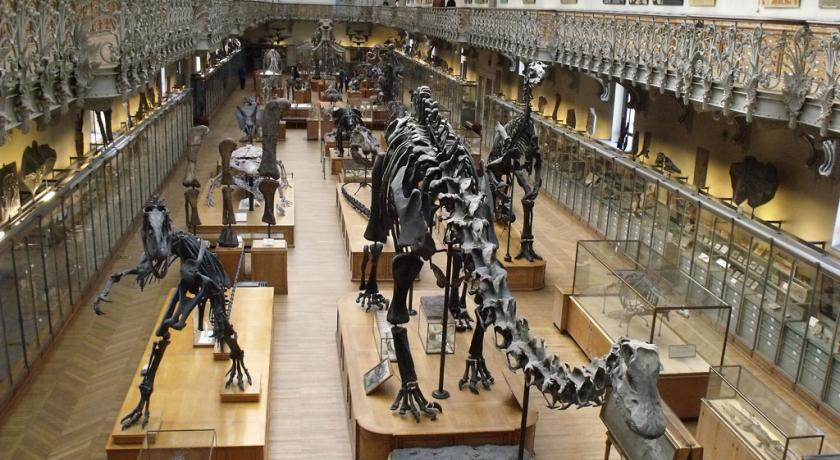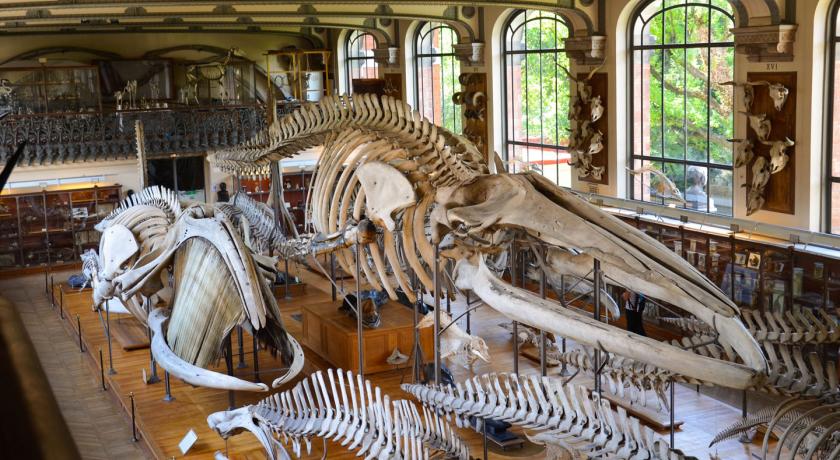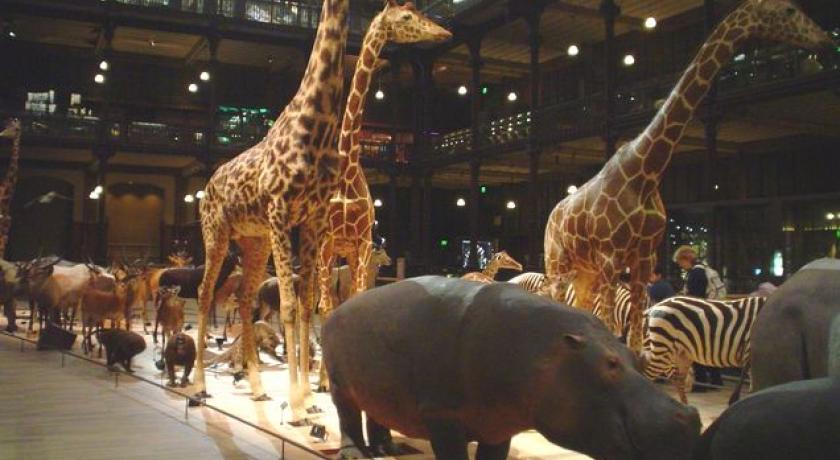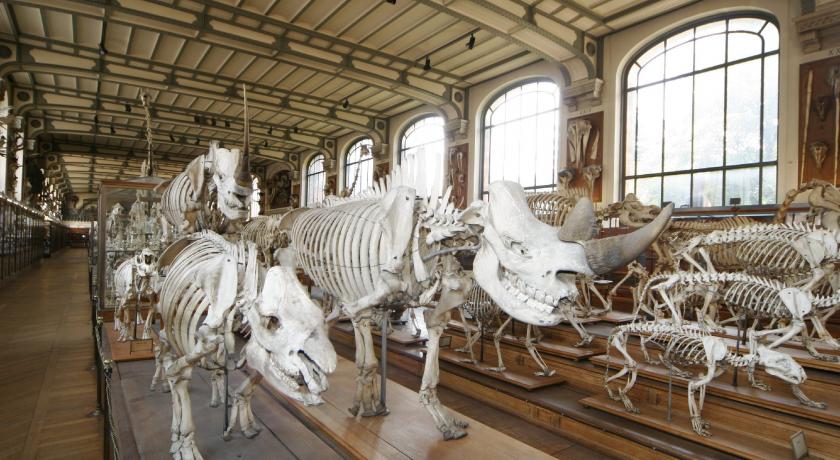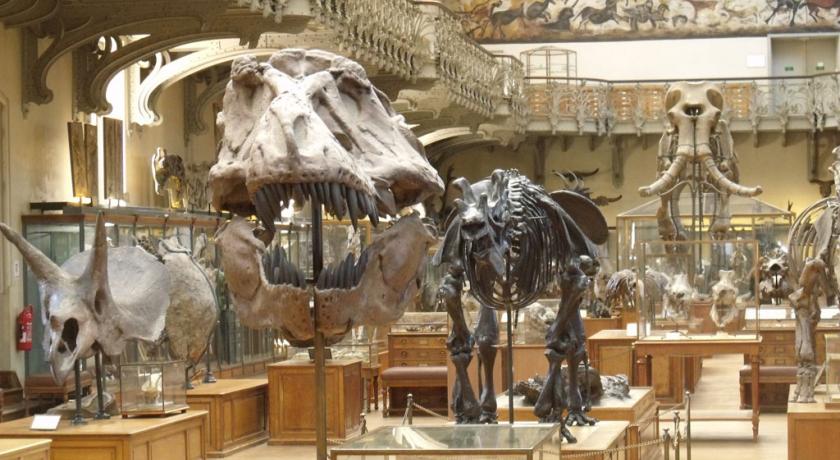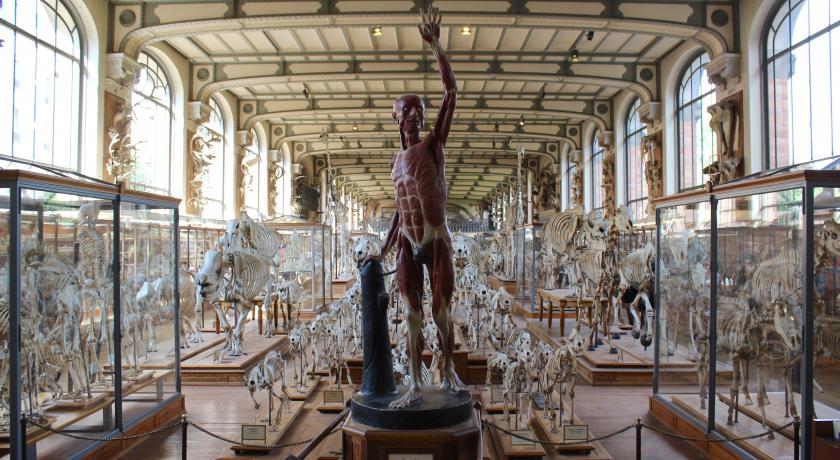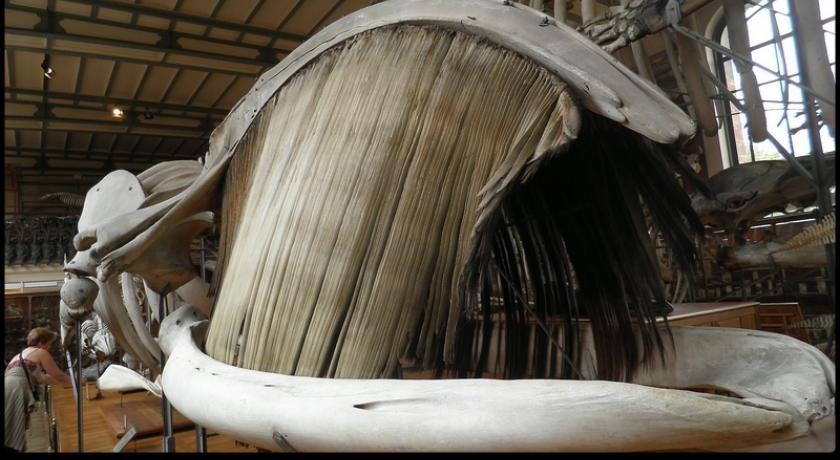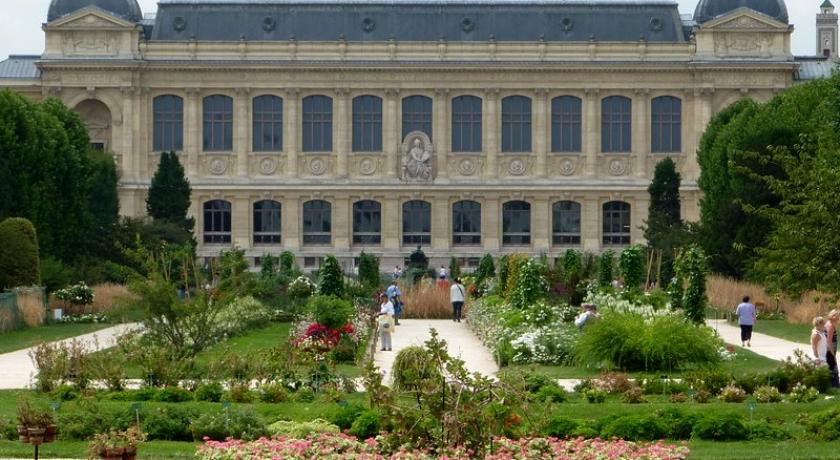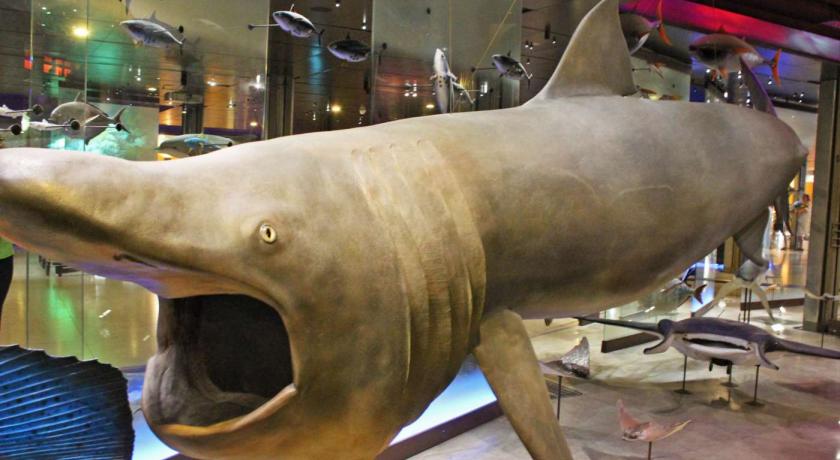Description
The national Museum of natural history (MNHN) is a French research institution and dissemination of naturalistic scientific culture. It is one of the first global establishments of this type, if not the first, considering that the current Museum is the heir of the royal garden of medicinal plants, founded in the year 1626. The current national Museum of natural history, founded in the year 1793, was endowed with great facility status and placed under the joint responsibility of the Ministers of higher education and research and the environment. Its headquarters is located in the garden of plants but it has other sites in Paris and in France. The Museum has a staff of about 2,000 members including 450 researchers. Since the reform in 2014, it is headed by a President, assisted by Directors-General delegates.
Specificity and the Museum facilities
The national Museum of natural history presents an originality in comparison with its counterparts in other countries, which makes it a unique case because it is not composed of a single site but includes thirteen, of which are multifunctional: so its Parisian headquarters isn't just a building, but at the same time a botanical and zoological garden and a set of several scientific galleries laboratories and greenhouses. Large budgets are necessary to maintain, operate and renovate these sites according to current standards (security and other): paid entries are not sufficient to cover these expenses and some had to be closed for this reason. All was not able to be rehabilitated and thus the Entomology Gallery was closed in 1996.
There are four sites in Paris a total of 41.2 heactares:
Paris
In Paris there are four Museum sites:
- The plants garden, with its annexes, specialized gardens, greenhouses, menagerie and galleries (25.7 ha with the "clos Patouillet", located outside the perimeter of the garden, on the pavement opposite the street of Buffon):
- The Great greenhouses of the plants garden (closed in 2005, renovated and reopened in 2010),
- Thee menagerie of the plants garden,
- The Magny Hotel (headquarters of the Museum Direction, which hosted a "plants garden history Cabinet " from 2008 to 2017).
- The Grand Gallery of Evolution (closed in 1966, renovated in 1988 and opened in 1994),
- The children’s Gallery [archive] (opened in 2010 in the Grand Gallery of Evolution).
- The Gallery of Mineralogy and Geology (closed in 2004), partially reopened at the end of 2014 for the exhibition "Treasures of the Earth"
- The paleobotany Gallery, located in the same building as the Gallery of Mineralogy and geology closed since 1998. In order to give the public a general idea of the paleobotany discipline, a part of the collections of this gallery was transferred to the mezzanine of the paleontology Gallery.
- The Botanical Gallery (closed in 2008, renovated and reopened at the end of 2013),
- The Comparative Anatomy Gallery and Paleontology (plastered façade in 2015);
- The human paleontology Institute, Administered jointly by the prehistory Department of the national Museum of natural history and the Albert I of Monaco Foundation;
- The Human Museum (closed in 2009, renovated and reopened in 2015).
- The Zoological Park of Paris (14.5 ha, closed in 2008, renovated and reopened in 2014).
The Outside of Paris
Outside Paris there are nine Museum sites namely:
- The Ecology Center, in à Brunoy,
- The Chevreloup arboretum, at Rocquencourt,
- The Zoological Reserve of the Haute-Touche, in Obterre
- The Harmas of Jean - Henri Fabre in Sérignan-du-Comtat,
- The marine biology station - marinarium of Concarneau, managed jointly with the College of France,
- The research and teaching center on coastal systems (CRESCO) in Dinard,
- The site Museum of the Pataud shelter, at Eyzies,
- The Alpine Botanical Garden La Jaÿsinia in Samoëns,
- The exotic Botanical Garden of Val Rahmeh, in Menton.
Missions
The founding statutes of the current Museum, in 1793, establish its five main missions:
- The preservation of scientific collections with about 67 million items as well as living species at 12 sites in Paris and the rest of the France;
- The dissemination of scientific culture in the property-specific specialties;
- research;
- teaching [archive] and research training (Master and PHD);
- The scientific expertise.
These specialties cover disciplines specific to the natural history, namely:
- The Organization study and the functioning of the living world (systematics, compared Anatomy, biochemistry, biophysics, Physiology...);
- The study of the animal world (zoology and derivative disciplines);
- The study of the fungi world and myxomycetes (Mycology and derivative disciplines);
- The study of plant world (botany and derivative disciplines);
- The study of single-celled life, eukaryote, Archean and bacterial (Microbiology and derivative disciplines);
- The study of the Earth and mineral world (geomorphology, ecology, mineralogy, Petrology, and derived disciplines);
- The study of the evolution of life, through its mineral or genetic traces (paleontology, genetics, and derivative disciplines);
- The study of the evolution of the human lineage, its insertion in the environment, its impact in the environment, the relationship between the human species and environments, the relationship between nature and culture (Anthropology and disciplines derived such as ethnobotany).
In the expression 'natural history', the word 'history' refers to the evolution of our planet, of life (paleontology) and of the human lineage (Anthropology) and the word 'natural' refers to the biodiversity of our planet. The paleontology Gallery and comparative anatomy and evolution are also the most visited. In the 21st century, natural history is more than ever topical as a multidisciplinary systems approach, covering without pitting against them both human nature, the environment and development, promoting preservation. The "naturalistic science culture", at the Museum, is an integral part of culture (see EEDD).
History
The national Museum of natural history was founded the 10th of June 1793 by the Decree of the Convention. This is the metamorphosis of a 'Garden of Utopia' the royal garden of medicinal plants which already provided the knowledge of the scholars who administered it, and which was created in the 17th century on the land pf Alez, in the 16th century, the apothecary philanthropist Nicolas Houel gave courses of herbalism. On this site, the tradition of teaching natural history dates back to almost five centuries.
17th century
In the year 1626, one of the King’s physicians, Guy de la brosse, supported by the first physician Jean Heroard, and by Richelieu, persuaded Louis XIII to create in Paris a "garden of medicinal plants. A new royal edict was proclaimed in the year 1635 and the royal medicinal plant garden, finally opened in 1640, to serve on the one hand, to the culture, preservation, study and utilization of useful plants to health, and, secondly and destined for future doctors and apothecaries, to the teaching of Botany, chemistry and anatomy. These courses, was taught in French (this is a first, because everywhere else is in latin), are also available to the general public. They are provided by "demonstrators" and get a great success: listeners of all ages, French and foreign, are attending the lessons given to the garden.
Originally intended for the botanical collections and the needs of the Royal House (where the name of "royal garden of medicinal plants"), The Garden arouses the hostility of the medical Faculty, only in Paris, to be able to award the medicine degree of doctor. Besides, the demonstrators are all doctors, but trained them in the province, and especially in Montpellier, a rival and hated faculty. Another topic of aversion is the new disciplines taught in the garden, such as chemical medicine or the circulation of the blood, which are the heresies for the Parisian academics, keepers of the Hippocratic and galenic traditions. Until the end of the 17th century, the Parisian Faculty of Medicine did everything it could to oppose the decisions taken by the Superintendent or the intendant of the garden in front of the Parliament.
In 1693, Guy Crescent Fagon access this last function by becoming the first doctor of King Louis XIV. A nephew of the founder Guy de la Brosse, his administration was remarkable: it soothes the conflict that became acute with the University of Paris, recruited competent staff (such as Tournefort, one of the fathers of French Botany, valiant, but also Antoine de Jussieu, founder of a dynasty of botanists) and finally to encourage study tours in distant countries. From this period date the first collections of the garden, originally constituted by missionaries (Charles Plumier between 1689 and 1697 in the Antilles, Louis Feuillée between 1703 and 1711 in the Andes...), then by doctors (Augustin Lippi in 1704 in Sudan and especially Tournefort in the Eastern Mediterranean and in Anatolia from 1700 to 1702). Fagon favor the importation and acclimatization of tropical plants, including coffee, until then a monopoly of the ottoman empire, Jussieu introduced to the West Indies.
18th century
In the 18th century, the activity has diversified: from the art of healing plants, we pass gradually to natural history. The day after the death of Louis Poirier, the King’s first physician, the royal decree of the 31st of March 1718 separated this office from the Superintendent of the garden of the royal plants, and in 1729, the former "droguier' which gradually lost its dispensary appearance, and officially took the title called "cabinet of natural history ".
Ten years later, in 1739, "The King's Garden" as it is now called, takes a new dimension, thanks to one of the most prominent scholars in the 18th century: Buffon (1707-1788). This complete naturalist (he published throughout his mandate the monumental natural history in 36 volumes, a true bestseller at the time), Member of the French Academy and perpetual Treasurer of Sciences, lead the institution for nearly half a century, until his death in 1788. Thanks to him, in 50 years the garden double its area, the school of Botany as well as the cabinet of natural history were enlarged and, before his death, a vast amphitheater and a new greenhouse are underway.
Like Fagon, Buffon recruited new and prestigious naturalists: André Thouin, Antoine Laurent de Jussieu, the brothers Rouelle (Guillaume-François 'The eldest' succeeded Hilaire Marino 'the cadet'), Fourcroy, Martrud, but also Daubenton, Lamarck or Dolomieu. The Travel discovery and study with naturalistic point follow one another: Jean André Peyssonnel discovered the animal nature of coral living on the coasts of 'Barbarism' (1725); Joseph de Jussieu spent 35 years in the Spanish Peru (1735-1770) and contributed greatly to the knowledge of the Cinchona, discovered by La Condamine; John the Baptist Christian Fusee-Aublet explores Guyana (1762-1764) as well as Louis Claude Richard (1781-1789). In the Indian ocean, Pierre Poivre acclimates the spices in Mauritius (1770) while his cousin Pierre Sonnerat accomplishes several journeys to the East Indies at the end of the 18th century. Others, such as the botanist Philibert Commerson or the gardener Jean Nicolas Collignon, accompany the Bougainville and Lapérouse . In half a century, the energy and hard work of Buffon make the garden one of the scientific headlights of the 18th century, international notoriety.
At his death in 1788, the King appointed a soldier at the Head of the garden, Auguste de Flahaut, who did not know much about science or even horticulture, and whose naturalist complained in vain to the King the naturalist Louis Daubenton Jean-Marie and the staff of the garden, including the demonstrators.
French Revolution
The Revolution profoundly changed the functioning of the garden. On the 20th of August 1790, a decree of the National Assembly asked the demonstrators to draft a project for its reorganization. The first Assembly votes the departure of Auguste de Flahaut and elects unanimously Daubenton president. The latter commissioned Antoine-François Fourcroy, Bernard Lacépède and Antoine Portal to write out the rules of the new institution and to establish the operation and the missions of the Museum: to educate the public, to put together collections and participate actively in scientific research. The body of the professors and their Director, is elected and renewed each year, had to be the guarantors of the independence of the research
But, taken by the political news then tumultuous, the National Assembly left this project aside. In 1791, Flahaut resigned, replaced in 1792 by Jacques - Henri Bernardin of Saint-Pierre. It was not until 1793 that Joseph Lakanal (1762-1845), bringing the collections of the prince of Condé met with Daubenton and discovers the project of 1790. Lakanal leeds him to the Assembly, and the next day on the 10th of June 1793, obtain the decree vote establishing the Museum, giving the garden a clean legal existence.
The steward position is then replaced by the post of a Director. The old hierarchy of the garden officers, including demonstrators and sub-demonstrator, was abolished. Twelve faculty positions ensure the administration of the Museum equal and collegiate way. The lessons are divided into twelve professorial chairs.
19th century
With two prestigious scientists, Georges Cuvier and Étienne Geoffroy Saint-Hilaire, the study of animal life in the early 19th century took advantage over plants, which prevailed until then [t 6]. Geoffroy St-Hilaire, close to Lamarck shape ideas, created the menagerie in 1793 and stood during the first third of the century to Cuvier, supporter of doomsday and fixists theories. By asserting the transformation of gradual and successive species over generations and over time, long before Charles Darwin, Lamarck and Geoffroy St-Hilaire before half a century the publication of the origin of species in 1859. Various theories or discoveries emerge in the Museum: the principle of correlation of forms on which Cuvier based the comparative anatomy and Paleontology, the series of Chevreul work on fatty bodies, the research of Charles Naudin, who form around 1860, at the same time as Gregor Mendel, the essential genetic laws or even the discovery of radioactivity in 1896 will was worth to Henri Becquerel, a few years later, in 1903, the physics Nobel Prize.
Other scientists will punctuate the life of the Museum in the 19th century, including Lacepede, Gay-Lussac, Milne Edwards father and then son, Chevreul, Alcide of Orbigny, the lineage of the Becquerel or Claude Bernard. Most of them are members of the Academy of sciences or the Academy of medicine. Many teach at the College of France or at the Parisian central school (École Centrale Paris).
The Multiplication throughout the 19th century of the exploration voyages greatly increased the collections: Napoleon Bonaparte expedition from Egypt in 1798 to 1801, attended closly 170 scientists including Geoffroy Saint-Hilaire, Alexander von Humboldt in South America (1799-1804) or that of Nicolas Baudin in the southern land (1800-1803). These were Followed by Augustus Saint - Hilaire in Brazil (1816-1822), of Claude Gay in Chile (1828-1842), David Abbot in China (between 1862 and 1874) or Alfred Grandidier in Madagascar (1865-1870). And let's not forget one of the first expeditions specifically oriented towards paleontology, that of Albert Gaudry at the site of Pikermi in Greece (1855-1860). And the list of expeditions involving the scientists of the Museum is far from exhaustive.
To keep the collections thus enriched, the old Castle bought by Louis XIII in 1633, at the time of the royal garden creation of medicinal plants, has already been redesigned and expanded throughout the 18th century, presenting a façade of 120 meters along the Geoffroy-St.-Hilaire street under the Empire. But these proved insufficient, extensions were built: Charles Rohault de Fleury builds a new gallery of mineralogy in 1833, the first building specifically intended to be a Museum in France. At its end, a large space has been reserved to house the herbaria, also more and more numerous. The same architect also raises two elegant twin’s greenhouses, restored in 1980-1981 and still in service. Finally, between 1877 and 1889, Jules André built the Gallery of zoology and, at the extreme end of the century (1898), was inaugurated the Gallery of palaeontology and comparative anatomy.
With the appointment, in 1836, the chemist Eugène Chevreul (1786-1889), the Museum became interested, as its "rival" the Parisian Faculty of sciences, in physical, chemical and universe science, where the creation in 1837, for Antoine Becquerel, of the Chair of applied physics. This period ends with Alphonse Milne-Edwards, in 1890, and the promulgation of the Decree of December 12, 1891, which marked the return of natural biological history based on the study of collections (this policy will remain in effect until the eve of the second world war). In the meantime, the Government of Napoleon III in 1863 had adopted a decree establishing the mandate of the Director for 5 years without limitation of renewal: Chevreul remain for 28 years. The number of chairs also increases and some are divided into two as the disciplines specialize.
To enrich the collections through the expansion and exploration of the French colonial empire, a 'colonial school' was established in the year 1889 and a special course for travelers was developed in 1893, even before the Ministry of the colonies (which dates from 1894).
Too large to be fully presented, the collections of the Museum are the temporary exhibitions that had a great success. One of the first, in 1884, devoted to Oceanographic campaigns of workers and the Talisman; visitors could see (dredges, sensors, thermometers) devices used by researchers embedded as well as many samples in jars of animals (fish, crustaceans, echinoderms, mollusks and zoophytes) collected up to 5,000 meters of depth (a time performance). The naturalist work in Antarctic and ethnographic in Tierra del Fuego on the Selknams by Émile Racovitza of the Belgica expedition as well as the laboratory of the ship were also exposed in the old Gallery of the Duke of Orleans Buffon Street.
20th century
The Financial law of 31st of December 1907 gives the Museum financial autonomy and own budget of 1 million francs of that time (as much as the budget of the Faculty of science). In the same year Edmond Perrier, Director of the Museum, decided to found the society of the friends of the MNHN with the aims to give its moral and financial support to the Museum. At the beginning of the 20th century, the collections of the Museum increased considerably. Traveling from Alfred Lacroix in Martinique as a result of the eruption of Mount Pelée in 1902, until Robert Gessain in the late 1970s in Greenland, through Henri Humbert in Madagascar (between 1912 and 1960), Marcel Griaule between Dakar and Djibouti (1931-1933) or Henri Lehmann (1901-1991) in Guatemala (1954-1969).
After the first world war, the Museum acquired new institutions in and outside the capital. In 1922, he inherited the property of the entomologist Jean-Henri Fabre in Sérignan-du-Comtat, near Orange. To support its research activities related to the sea, he implemented, in 1928, his Marine Laboratory in Saint-Servan, then at Dinard in 1935. His botanical work was not wavered, he became the owner by legacy of the area of Chevreloup, in 1934. The same year, the president of the Council inaugurated the Park Zoo of Vincennes, followed a few years later by the Human Museum, installed in the new Trocadero (1937).
On the eve of the second world war, the Museum has 19 magisterial chairs for as many teachers-administrators. During the four years of Occupation, with energy and food shortages cause the loss of a part of the living collections (greenhouses, menagerie and Vincennes zoo). The organization houses resistance networks: one at the garden of plants around professors Roger Heim and Jean-Pierre Lehman, the other in the Human Museum in the team of the PR. Paul Rivet. After the war, Roger Hein runs the Museum from 1950 to 1965, managing to restore the institution in a difficult context (natural history being, economic growth, often considered a 'minor discipline' and obsolete). Recognizing the imbalances and overexploitation of resources by human expansion, Heim contributed in 1948 at the creation of the International Union for conservation of nature (IUCN). In 1962, he moved to the Museum a "nature conservation service" that evolves in 1979 "secretariat of the fauna and flora", then in 1992 "delegation permanent environment. During this period, the Museum acquires Pataud shelter in Dordogne (1957), the Zoological Reserve of the Haute-touche in the Indre (1958) and the Botanical Garden of Val Rahmeh in Menton (1966).
Throughout the twentieth century, new environments that have not yet been explored are discovered: penetrating further and further inside the primary forests, technical means allow to explore the ocean and discover that life there is. In fact, since 1882, the Museum has a marine laboratory opened on the island of Tatihou, in front of Saint-Vaast-la-Hougue near Cherbourg, then moved to Saint-Servan (near Saint-Malo) in 1928, then to Dinard (1935). The station of marine biology of Concarneau, founded by Victor Coste in 1859, is managed since 1996 by the Museum in equal numbers with the College de France. We also discover that life lies inside the caves that René Jeannel and Norbert Casteret explored. Scientists are pushing the boundaries of their research to cover the whole of the biosphere. The Museum is also interested in space since its collections include extraterrestrial materials as meteorites and some stones of Mars.
At the Museum the human are well understood as a party and a player in the natural history: the life of indigenous peoples for example is studied by Ethnography that develops in the second half of the 19th century, led to the creation, in 1880, the Ethnography Museum of Trocadero, attached in 1928 at the Museum and transformed into a Human Museum. ten years later. This museum collects also more and more fossils of hominids: among its rich collections, you can see the skull of Tautavel man, the Java Pithecanthropus, a plaster cast of the famous australopithecine nicknamed "Lucy" (including the original fossil, preserved in Ethiopia, is more than 3 million years old), or even the tomb of La Chapelle - aux-Saints or that of the Lady of Cavillon dating from 26,000 years. The fossils of other animals are not left behind. Installed in the Gallery of Palaeontology of the Buffon Street, we find among others the famous Mosasaur of Maastricht, a large specimen of Megatherium, at least two complete mammoth skeletons, the skeleton of the Aepyornis offered by the American Andrew Carnegie in 1908, the fossils of the 1985 excavations in Canjuers var, including an adult or sub-adult of Compsognathus, a plaster cast of that which was in 1908 the first complete skull of Tyrannosaurus , or even an authentic fossilized skull of Triceratops that the Museum had acquired in 1912. But these are mostly complete skeletons of dinosaurs which meet in this gallery the most successful (Diplodocus, Allosaurus, Iguanodon, Carnotaurus, Unenlagia, Dromaeosaurus, Bambiraptor...).
During the 20th century, temporary multiply exhibitions. The tercentenary of the royal garden of medicinal plants, in 1935, deploys all the Rainbow of the various fields of natural history and traces the history of the Museum. From February 2008 to January 2017, this story was exposed in the "history of the jardin des plantes firm" (in the sales of the Hotel of Magny, but this " history cabinet " is now dissolved). Over the years, the museographer of exhibitions was accompanied by beautiful catalogs. The most visited include orchids and epiphytes in 1966, Meteorites, messengers of the cosmos in 1968, the Nature with the electron microscope in 1971, the Sahara before the desert in 1974, the most beautiful shells from the world in 1975, natural history of sexuality in 1977 with André Langaney, bionic, science of the inventions of nature in 1985 and the giant crystals of Brazil in 1987, which together attracted more than 1 million visitors. A large audience also follows the debates and tutorial sessions.
From 1975, a rehabilitation plan of the premises and regrouping of the laboratories collection was put in place:the old 19th-century galleries were renovated, wings were added but spectacular achievements were also made, as evidenced by the underground animals opened in 1986 and designed to house the collections of the Gallery of Zoology, closed to the public since 1965. This gallery was reopened in 30 years later, in 1994, in the form of a "great Gallery of evolution" inaugurated by the president of the Republic François Mitterrand. For children, educational workshops are organized in 1970 under the aegis, among other things, Geneviève Meurgues, but take on a new dimension with the "children's Gallery", a permanent room of activities open in the Grand Gallery of evolution
Nearly 2 million people annually visit the various Parisian garden plants sites, including students attending the Museum, because it is also a campus and a training center for future researchers: since 1989, it delivers only doctoral regime and, since 1995,it has the Ministerial empowerment for seven new DEA.
Administratively, in 1968, a general meeting of workers (more than 2,200 people) had proposed to replace the faculty of teachers (established in 1793 as a unique governing body, both scientifically and administratively) by a Council of teachers, researchers and technicians which would be represented equally. This proposal failed, but over the years the Assembly of teachers lost prerogatives in favour of the Secretaries-General appointed by the ministries; in 1985 the Government enacted a new statute, putting an end to the role of teachers administrators, and in 1994 it installed three councils to ensure the management of the Museum: Board of Directors, Board of laboratories and Scientific Council.
Twenty-first century
The evolution of the institution’s statutes in the direction of a more complex growing (but not necessarily more functional) continued in the 21st century: The Decree of 2001 has created hierarchical intermediate levels between management and researchers, as well as cross-cutting structures to define the major missions of the Museum and to frame research. The duties of Directors are shared between presidents, who chairs the Board of Directors and an Executive Director, who actually runs the establishment. Both are now appointed for 4 years directly by the president of the Republic. The laboratories are grouped into departments to coordinate the activities of researchers. The establishment is now under the tutelage of three departments: Education, research and ecology. This system is so complex, that further changes are under discussion.
Today the Museum is responsible for the heritage conservation of 62 million specimens including many millions of 'types' of all kinds (see below), specimens, including hundreds of thousands of living plants and approximately 3 500 animals. With 1,800 people in France (not all in Paris), the majority of researchers and technicians, the Museum is a national and international role major in the development of natural history research and in the dissemination of scientific culture.
Scientific collections
With the Exception of living species, the specimens from the Museum collections are kept almost entirely on its Parisian sites as well as at Eyzies and Sérignan. They are, with more than 62 million specimens including a very high proportion of 'types', among the largest in the world with those of the National Museum of Natural History in Washington and the Museum of natural history in London: this heritage of mankind is essential to understanding biodiversity:
The algae collection of the botanical Gallery consists of an herbarium of about 570 000 specimens with an algotheque of about 1 000 listed strains of freshwater living algae.
The collection of mushrooms is composed of a collection of 500 000 specimens, a mycotheque with 4 000 live strains and 420 models colorful wax representing mushrooms in the Paris region, surgeon-major under Louis XVI made by André-Pierre Pinson.
The fossil collection is spread over several sites and includes more than 2.7 million specimens including:
- The collection of vertebrates including 300 000 specimens of mammals, reptiles, birds and fish;
- The collection of non-vertebrates comprising about 2.5 million specimens, particularly rich in tertiary mollusks from France and Europe;
- The collection of paleobotany including more than 200,000 copies of fossil plants;
- The collection of micropaleontology comprising more than 30,000 listed slides of foraminifera.
Libraries
The national Museum of natural history includes a library and documentation, which brings together the Central Library of the Museum and 22 libraries, some at the same Museum, others present at other sites of the Museum.
The cabinet of the King already included dozens of books at the time of the Revolution. However, the Decree of June 10, 1793 will create the conditions for its development. On other hand, the library receives an official existence, and the first floor was assigned. On the other hand, the decree pronounced the attribution to the Museum from the collection of "vellum of the King', always kept by the institution and now digitized, as well as the present duplicates of natural history books at the Royal Library. Above all, it allows the Museum to fuel its collections in literary deposits in the capital.
The library grows quickly, constituting an encyclopedic collection with a net interest in sciences, especially biological, and techniques. The library receives also important donations and legacies, including Georges Cuvier and Michel-Eugène Chevreul.
In 1823, the collections already reach 15 000 volumes. In 1833, the construction of the building of Mineralogy and the geology by Charles Rohault de Fleury provides an opportunity to install the library in a larger facility, opened in 1837. This new library will be used for more than a century, even while collections increased again (300 000 volumes around 1950). The architect Henri Delaage (1900-1992) designed the current building, opened on the 26th of June 1963, which includes two reading rooms and seven levels of shops.
The current collections of the Central Library can be estimated at approximately 200 000 volumes of modern books, over 13,000 periodicals titles (approximately 3 000 living), about 105 000 old prints, nearly 8 000 manuscripts, maps, prints and a thousand objects of art.
Since 1992, the Central Library has been a custodian of a "polar Fund" established by Jean Malaurie. it now also gives access to about ten databases and nearly 5 000 titles of electronic periodicals.
A media library, open to a wide audience, includes approximately 8 000 books, hundreds of periodicals and historical records.
The library budget is about 1.3 million euros. The library of the Museum is a Center for acquisition and dissemination of scientific and technical information (CADIST) and 'associated pole' of the National Library of France.
Among the 22 associated libraries, the library of the Human Museum has been largely transferred to the Museum of the Branly Quay, but practical and scientific considerations have led officials of this last Museum to restore an important part at the Human Museum. Through this library, the Museum is CADIST in another capacity.
Access
The national Museum of natural history, which has several entrances, Cuvier, Buffon and Geoffroy St-Hilaire, quai Saint-Bernard and Place Valhubert, is served by bus lines, the Paris Metro (stations station d'Austerlitz, Censier-Daubenton, Monge and Jussieu), RSP (Austerlitz station) and the port d'Austerlitz station and Botanical Garden of the Voguéo-Batobus network.
Source: https://fr.wikipedia.org/wiki/Mus%C3%A9um_national_d%27histoire_naturelle
Address
Paris
France
Lat: 48.842208862 - Lng: 2.356164694


